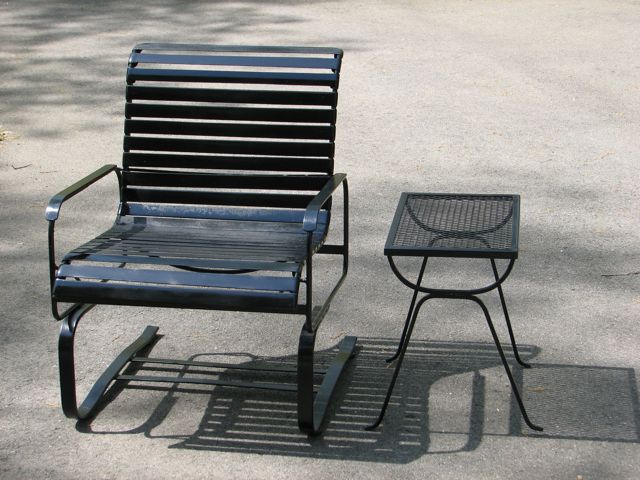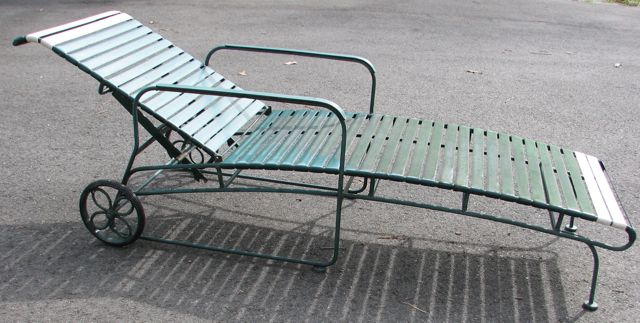Budget Patio Furniture Makeover
Today I am excited to debut phase one of our budget patio updates . . . our “new” patio furniture! Of course, it is really just the same old patio furniture but it has had a complete makeover.
When I was looking for ideas on what to do with the patio furniture, I considered a lot of options. I looked at the cost of purchasing new furniture and found that it would probably cost at least $1,000 to replace everything that we have now. The lower-priced furniture was also not of the same quality as what we already have.
Our current furniture was OK in terms of comfort. It just lacked style, was weathered, had peeling paint and grime and was not inviting. I wandered into the hardware section of our local Wal-Mart and saw this display.
It was like a beacon from above. Spray paint at less than $1 per can! The color choices were a bit limited and consisted of white or black in gloss or flat finish. I stocked the cart with gloss black.
Stage One: Repainting
Materials
- sandpaper/sanding sponges
- bucket
- dish soap
- sponges/car wash mitts/scrub brushes
- spray paint
- Rust-oleum spray trigger
- drop cloths
 As with any repainting project, the quality of your paint job primarily depends on the quality of the prep work you do before you paint. I sanded each piece to knock off peeling paint, dirt and whatever rust would come off easily. Since we are not trying to preserve this furniture forever and just want it to last another few years, I wasn’t hugely picky about the rust removal. On some pieces, the rust might be holding the furniture together!
As with any repainting project, the quality of your paint job primarily depends on the quality of the prep work you do before you paint. I sanded each piece to knock off peeling paint, dirt and whatever rust would come off easily. Since we are not trying to preserve this furniture forever and just want it to last another few years, I wasn’t hugely picky about the rust removal. On some pieces, the rust might be holding the furniture together!
 With the assistance of my little helpers, we got out the car washing supplies and washed off each piece with a little dish soap. The worst of the dirt was on the underside of the chairs. Due to our humid climate, the dirt was sort of like a mold that was stuck on tightly. We did our best to scrub it all off. Then, we hosed it off and let it dry in the sun.
With the assistance of my little helpers, we got out the car washing supplies and washed off each piece with a little dish soap. The worst of the dirt was on the underside of the chairs. Due to our humid climate, the dirt was sort of like a mold that was stuck on tightly. We did our best to scrub it all off. Then, we hosed it off and let it dry in the sun.
As I was cleaning the furniture, I learned that this is not the first time this furniture has been repainted. The original color was powder blue. I am not sure what decade powder blue was last in fashion, but I am guessing this furniture is over 20 years old! In the prior makeover, the owners painted the frames then restrapped the chairs with green and white plastic vinyl straps. Vinyl strapping can be kind of expensive and was out of the budget for this project so I decided to just paint everything, straps and all!
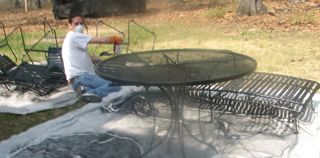 When it was finally time to paint, I spread out dropcloths on the grass (our poor lawn has enough problems without getting doused in paint) and laid the clean furniture on top. I donned my grubbiest work clothes and shoes, put on rubber gloves and a dust mask. (It probably would have been a good idea to wear goggles too but I didn’t take that step.)
When it was finally time to paint, I spread out dropcloths on the grass (our poor lawn has enough problems without getting doused in paint) and laid the clean furniture on top. I donned my grubbiest work clothes and shoes, put on rubber gloves and a dust mask. (It probably would have been a good idea to wear goggles too but I didn’t take that step.)
After a lot of practice (remember, I had 21 pieces of furniture to paint!), I found that the best technique was to turn the furniture upside down and paint the bottom first, then flip it over and paint the top side.
 Anyone doing a lot of spray painting (or any other sort of aerosol work) NEEDS to buy the Rustoleum trigger spray attachment. It only costs about $6 and will fit on top of any aerosol product. Instead of wearing your fingers out pushing down on the spray button, you just pull the trigger and it feels like you are painting with an airbrush. After a lot of use, the trigger becomes a bit weak and you sometimes have to jam the button on top down with your thumb but it it is still MUCH better than the alternative. I did my first four chairs without the trigger and my fingers were aching and numb by the end.
Anyone doing a lot of spray painting (or any other sort of aerosol work) NEEDS to buy the Rustoleum trigger spray attachment. It only costs about $6 and will fit on top of any aerosol product. Instead of wearing your fingers out pushing down on the spray button, you just pull the trigger and it feels like you are painting with an airbrush. After a lot of use, the trigger becomes a bit weak and you sometimes have to jam the button on top down with your thumb but it it is still MUCH better than the alternative. I did my first four chairs without the trigger and my fingers were aching and numb by the end.
Since I chose a dark color, I fortunately only needed to do one coat. Black was a good choice for our furniture because even if there were spots where the old green color showed through it blended with the black and just gave a depth to the new black color. As an experiment, I did paint two of the chairs white. They were already a white/cream color. If you choose white as your color, just be prepared that you need to be generous with the paint and you might need to do a primer coat depending on what you are painting over.
We were having good weather so I let the chairs dry overnight outside and then in the garage for about a week to let the paint cure. The fumes are pretty intense so it is a good idea to make sure you keep the air flow circulating for several days.

Painting outside is a bit challenging because you can’t control the weather or the air quality. One day, I had to hurry and rush all the furniture into the garage as a rainstorm was approaching. We are also having record pollen counts lately, particularly from the big oak trees in our yard, and everything is covered in yellow-green dust. The spray paint dries quickly so the pollen did not embed in the paint. After the paint had cured for several days, I could easily wipe the pollen off with a wet cloth and it did not ruin the paint finish.
The day after painting, I sometimes needed to do a few touch ups but it was pretty much a one coat job! Hooray!
Before the green and white chairs were OK but nothing special. Doused in black, they have a new elegance and a contemporary feel. My husband even likes them!
Here are some before and after shots.
Stage Two: Cushions
Materials
- Fabric of your choice
- Foam/Stuffing
- Thread to match
- Pins
- Hand Sewing Needles
If the cost of new patio furniture doesn’t get you, then the cost of cushions will! I was quite astounded at the cost of cushions and the limited selection of colors and sizes. Chair pads were $9-20 each and larger cushions were in the $20-40 range. I didn’t want to spend a lot on the cushions either and wondered if it would be possible to make my own for less.
My first stop was the fabric store. There were a variety of colors and patterns in the outdoor fabrics section but it all started at about $9 per yard. There was no way this was going to be less expensive than buying cushions. Way back in the corner of the store, however, I spotted some vinyl fabrics typically used for tablecloths. There were some really cute patterns to choose from and the prices ranged from $2.99 to $4.99 per yard (when I checked out, I learned that there was a 40% off special going so they were even cheaper at $1.79 to $2.99 per yard!). I bought about 12 yards.

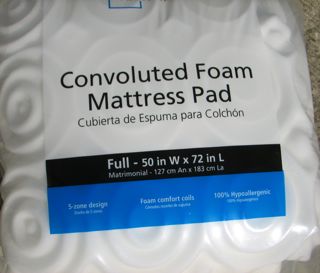 The foam material for the cushion part was the most expensive, however. The fabric store only sold upholstery grade foam which was about $40 for a long piece. I had a lot of chairs to cover, including a very long chaise, so I knew this wasn’t going to work. I did buy 4 square chair cushions in NU-Foam on sale for $3.49 each and went home to research online about options for the bigger pieces.
The foam material for the cushion part was the most expensive, however. The fabric store only sold upholstery grade foam which was about $40 for a long piece. I had a lot of chairs to cover, including a very long chaise, so I knew this wasn’t going to work. I did buy 4 square chair cushions in NU-Foam on sale for $3.49 each and went home to research online about options for the bigger pieces.
There weren’t many online options for foam either. At this point, I began to despair that the cushion project wasn’t going to work out. I racked my brain for sources of foam and remembered that once we had purchased an inexpensive foam mattress topper for an old bed. Back to our local Wal-Mart where foam mattress toppers were available for $15-20 each. Hooray!
Making a chair cushion is super easy and requires only basic sewing skills.
1. Measure. Measure your furniture and decide on the closest square or rectangular shape that fits your piece.
2. Foam. Cut out your foam to fit this measurement.
3. Fabric. Fold the fabric you are using in half and lay the foam on top of the folded fabric. Give yourself about an inch around the foam and cut out the fabric. You want two separate pieces.
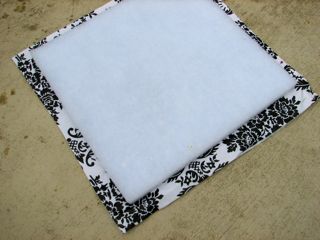
4. Cut Ties. Decide where on your cushion you want to add ties to tie the cushion to the chair and hold it in place. For each tie, cut out a strip of the vinyl fabric approximately 1” wide by 20” long.
5. Fold and Pin Ties. For each tie, fold about 1/4” of the short end of the tie fabric under. Working in 2-4” increment, then fold in about 1/4” on each side. Then fold the strip in half and pin. This is a great task to do while you are watching TV. The finished tie is about 1/4” wide. It is better to choose a relatively thin vinyl fabric for the tie material.



6. Sew Ties. Run a line of stitching about 1/8” along the folded edge to secure the ties. Trim ends.
7. Pin Cushion Material and Ties. Turn the cushion fabric right sides together and pin it in a few places to hold in place. Decide where you want the ties to go.Fold each tie in half lengthwise and pin with the tails sandwiched in between the two right sides of the fabric. In the corners, I placed each tie diagonally right in the corner.
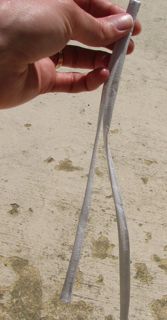

8. Sew Cushions. You are going to leave one end of the cushion open so you can insert the foam. Start at the narrowest end of your cushion. Start sewing about 2” from the corner, backstitch and sew all the way around three sides of the cushion, stopping 2” after the last corner. For durability, I ran a second line of stitching about 1/8” from the first seam.
9. Turn Cushion Right Side Out and Insert Foam. It is easy to pull out the corners that have ties. Just grab the ties and pull!
10. Stitch Closed By Hand. Fold about 1/2” of material on either side of the open end, pin the sides together and handstitch closed using a blind stitch.

You could potentially use whatever type of fabric you wanted so long as you are willing to bring the cushions in every day and not leave them outside where they could fade or mold. I used the vinyl fabrics for this reason to give us a little more durability in case we forgot to bring them in one day. You could also add zippers to the cushions so you can wash them periodically but this was too much work for this project. I wanted something I could just hose off.
The cushions really add a level of polish and fun to the furniture makeover. My patio chairs now look like they went to Paris. The cushions cover up some of the degraded vinyl straps and add more cushiony comfort as well. Since they are custom-fit, they also tend to look a little better than store bought cushions as well.

Total cost for this makeover?
Spray paint and trigger applicator $46
Fabric $30
Foam $50
Total $126
$126 for 21 pieces including 8 chairs, 2 large tables, 5 side tables, 4 rocker lounges, a chaise and a glider swing was a good value for us. Per chair, it was about $2 in paint and about $3 in cushion materials. For larger pieces like the chaise lounge, it was about $4 in paint and about $15 in cushion materials.
With a little sweat equity perhaps you might also decide to recycle your old patio furniture. Use the money you save on your summer vacation and get your arms in shape for swimsuit season with all of the sanding and painting work!
More to come later on the patio project. What do you think so far? Please share in the comments.
Update! You may also like:



